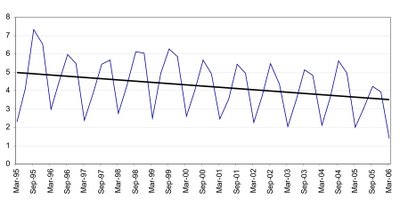Imports into Armenia stood at USD 1768 million in 2005, which represents an increase of 31 percent over 2004. Armenia
exported USD 950 million in goods in 2005, also representing an increase of 31 percent. Perhaps this rapid growth in trade is not surprising. However, the recent emergence of Germany and the Netherlands as major trading partners of Armenia was quite unexpected. These two countries are the leading export markets for Armenian goods, and account for almost 30 percents of all exports. Below are the exports to the top 10 markets over the past five years.
Exports ...... 2001 2002 2003 2004 2005
Total ........... 342 505 686 723 950
Germany.... 11 28 44 83 147
Netherlands 1 11 22 26 130
Belgium ..... 46 92 124 108 125
Russia ........ 61 65 94 78 119
Israel ......... 33 88 142 98 112
USA ........... 52 46 56 71 62
Georgia ..... 12 17 19 29 39
Switzerland 9 8 33 45 35
Italy ........... 6 12 19 28 26
Iran ............ 32 31 22 31 25
What is Armenia exporting to Germany and the Netherlands? I suspect much of this is perhaps metal products such copper and aluminum.
Exports of non-precious metals, for instance, expanded from USD 138 million in 2004 to USD 315 million in 2005. Is there anyone who can shed light on this? I presume much of the exports to Belgium and Israel are polished diamonds.
Imports also kept pace with exports, but with some reshuffling of the leading trade partners. Russia is the leading exporter to Armenia, and the primary source of energy imports. Russia, Belgium, and Israel are also important sources of uncut diamonds. Not sure what Armenia imports from Germany, UK, and Switzerland. Again, it will be great if anyone out there can shed light on this. Below are the imports from the top 10 leading countries over the past five years. What is Panama doing on this list, and what does Armenia buy from it?
Imports .... 2001 2002 2003 2004 2005
Total ........... 877 987 1279 1351 1768
Russia ......... 174 193 203 180 259
Belgium ...... 42 91 129 109 162
USA ............ 84 53 111 105 116
Germany ... 34 43 44 74 114
Israel ......... 28 83 124 100 102
Iran ............ 78 63 70 76 102
UAE ........... 47 43 60 65 98
UK .............. 91 28 83 107 91
Switzerland 27 10 53 46 86
Panama ..... 19 3 38 46 71
Imports are likely to expand as Armenia’s economy expands. Growth in exports is more tricky to predict as it depends on supply factors or constraints. Indeed, other than cut diamonds and the recent surge in non-precious metals, Armenia exports very little. Is there a good explanation for this? Has anyone looked at how sensitive exports and imports are to the appreciation of the
Dram? Is anyone aware of any studies or business surveys of future trends in trade?
[Please email me if you are interested in contributing.]
 Are there any studies exploring the reasons for this trend?
Are there any studies exploring the reasons for this trend?